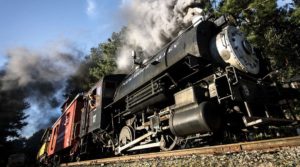Steam Locomotives
Click here for details on Locomotive 110 Restoration Project
Cliffside #110 was built for a logging railroad tied to McRae Lumber and Manufacturing Company in Quincy, FL (now part of Rex Lumber Co) and worked for them from 1927 until 1930. #110 was sold in 1963 to Echo Valley Park in Cleveland, S.C. and ran on the amusement park’s “Swamp Rabbit RR”. Then the locomotive was sold to Stone Mountain Scenic Railroad in 1969. Being the smallest and slowest steam locomotive at Stone Mountain, it saw little use at the park. In 2012, the Stone Mountain Memorial Association donated the #110 to the North Carolina Railway Museum. In February 2013, #110 was moved from her display location to Stone Mountain RR Shops for transport to Bonsal, N.C. Builder: Vulcan Iron Works. Built: July 1927. Type 2-6-2. Builder’s Number: 3739. Status: Restoration. Read more about the Cliffside #110 project.
Steam Engine #17 carries its fuel and water supplies on board, not in a separate tender. Most of this type of locomotives were used in industrial or railroad switching service due to their small size. Builder: Vulcan Iron Works. Built: April 1941. Type: 0-4-0. Builder’s Number: 4309. Status: Out-of-service for mandated, 15-year, Federal Railroad Administration inspection. See the last run on YouTube
Diesel Locomotives
1686: This engine is currently NHVR’s primary motive power. Execpt for having been build eight years apart, 1686 is virtually identical to locomotive #71. 1686 worked for the North Carolina Ports Authority (ex. Beaufort and Morehead) in Morehead City, N.C. alongside B&M #75 (now at Bonsal) and B&M 1860 (now at Spencer Shops). Builder: General Electric. Type: 80-ton Diesel-Electric. Built: March 1953. Builder’s Number: 31818. Status: Operational.
399: This engine is currently NHVR’s primary motive power. #399 is a 65-ton GE center cab acquired from military surplus. Originally, U.S. Navy #65-00399, she served at Theodore, AL – Naval Ammunition Magazine. She became U.S. Marine Corps #289330 and served at Camp LeJeune, NC before coming to Bonsal. Builder: General Electric. Type: 65-ton Diesel-Electric. Built: March 1943. Status: Operational.
70: This locomotive is similar in appearance to the GE center-cabs with some design elements common to industrial locomotives of its era. This locomotive has only one traction motor per truck and uses side rods to transfer power to the other side. Builder: Whitcomb. Type: 45-ton Diesel Electric. Built: April 1941. Builder’s Number: 60298. Status: Non-Operational.
10: This GE end-cab is an example of a very small, no-frills locomotive design used by many industrial and short line railroads. The smallest of the NHVR locomotives, it has only one powered axle (traction motor), and uses a chain-drive to transmit power to the other axle. Builder: General Electric. Type: 25-ton Diesel Electric. Built: April 1950. Builder’s Number: 30590. Status: Non-operational. Read more about #10.
Cabooses
308: Aberdeen & Rockfish Caboose. Status: Operational.
328: Operational
Built for the Virginian Railway in 1949 as Virginian 328, Acquired by the Norfolk & Western Railway with the N&W purchase of the Virginian Railway in 1959
Renumbered to N&W 530328. Donated to the town of Archdale, NC and sold to a NCRM member in 2008 and was moved to the NHV the Monday before Thanksgiving of that year. The NCRM intends to paint the caboose as it would have appeared in service with the Norfolk and Western as N&W 530328.
302 / 309: Spent Nuclear Fuel Train Caboose – Restored
https://www.triangletrain.com/fuel-train-cabooses/
5228: Operational
Our 5228 caboose is an original 1926 Seaboard Air Line wooden caboose. Its interior gives an accurate representation of what it was like being a railroad conductor on a freight train in the 1920s-30s.
Passenger Cars
6929: Boston and Main RDC-9. Builder: Budd. Built: 12/1958. Status: Restoration. Read more about 6929.


